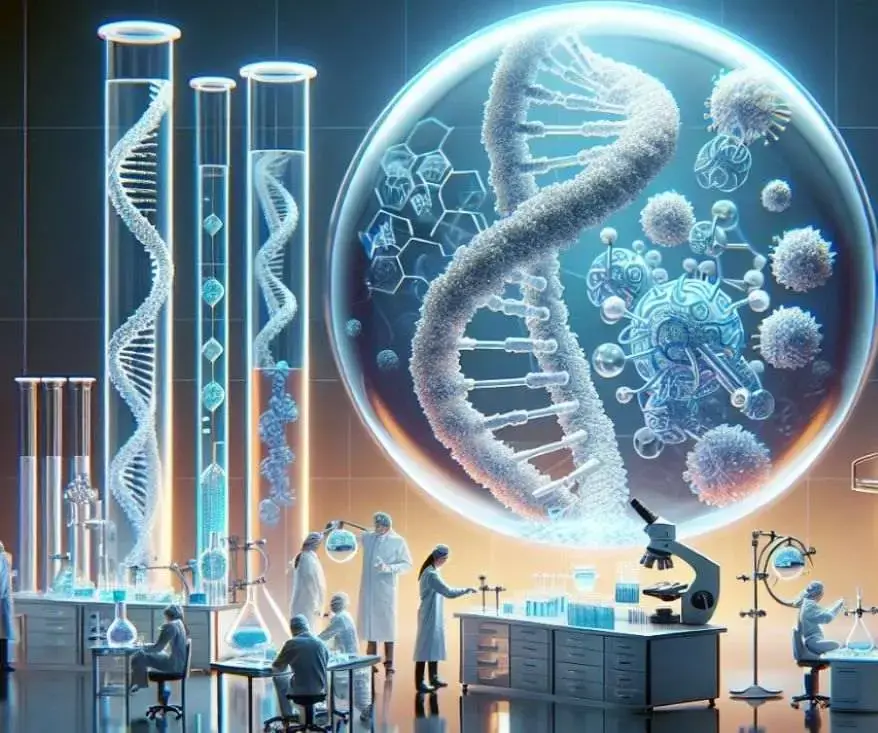Building 3D Nanostructures with DNA: A Revolutionary Approach
Scientists from Columbia University are using DNA, which is the biological instruction manual of life, to create tiny, complex structures. These structures could change the way we think about technology in areas like computing and medicine. The researchers have developed a method that allows DNA to form detailed 3D shapes called voxel-shaped scaffolds. These scaffolds can organize tiny parts more precisely, leading to innovative creations such as miniaturized electronics and brain-like circuits.
DNA as the Blueprint
The key to this innovation is the use of DNA origami. Scientists utilize DNA strands to create tiny, geometric shapes that serve as building blocks. These building blocks—called voxels—can be customized to bond with each other in specific ways, thanks to the sequence-specific Watson-Crick base pairing. This precise bonding ability is what allows for the creation of highly ordered 3D structures. Think of it like LEGOs, but on an incredibly smaller scale, with DNA encoding the instructions for how the pieces snap together.
Building with Biology
Imagine constructing a skyscraper, one floor at a time. That’s similar to how we’ve traditionally made tiny electronics. However, researchers at Columbia University are doing something far more innovative. They’re using DNA to create self-assembling nanoscale structures. This bottom-up approach uses DNA’s natural ability to self-organize into precise shapes, enabling the creation of complex 3D designs.
DNA Origami: Folding the Future
This innovative technique, often referred to as DNA origami, allows scientists to program DNA to fold into specific 3D shapes. These shapes then act as scaffolds, organizing other nanoscale components into intricate structures. Think of it as a highly precise and programmable self-assembly process.
Consequently, researchers can now create 3D nanostructures with unique properties, including light-reflecting crystals and even miniaturized electronics. This opens a world of possibilities for developing advanced technologies that were previously impossible to build at this scale.
Beyond the Basics: Applications and Possibilities
The implications of this DNA-based nanofabrication are far-reaching. For instance, scientists are creating tiny light sensors integrated onto microchips, which could lead to more efficient and sensitive devices. Furthermore, the technique holds immense potential for building brain-like circuits, paving the way for more powerful and energy-efficient computers.
Massively Parallel Assembly
Importantly, this method is far more efficient than traditional techniques. Instead of building features one by one, the DNA components self-assemble simultaneously, drastically reducing fabrication time. This approach also eliminates the need for complex and expensive equipment, making the process both faster and more environmentally friendly. The assembly process occurs in water, making it a sustainable technology.
Designing with DNA
Moreover, the researchers developed a sophisticated algorithm, called MOSES, that helps design the DNA sequences needed to create complex structures. This algorithm simplifies the design process, making it easier for scientists to create bespoke 3D nanostructures with specific properties. It’s like having a CAD program for nanotechnology!
Adding Functionality
Once the basic structure is built, researchers can add different materials to give the 3D nanostructures specific functionalities. For example, adding gold nanoparticles can create unique optical properties, useful for applications in optics and photonics. Similarly, other materials can be added to create structures with electrical or magnetic properties.
This breakthrough in nanotechnology shows the potential for biology to play a larger role in future technological advancements.
Future Applications of Hierarchically Ordered Nanostructures
This novel approach has a wide range of potential uses. For instance, interesting developments involve creating materials that mimic natural phenomena seen in biology. These materials not only exhibit superior mechanical properties but also have enhanced optical capabilities due to their structured organization.
Reference
- Kahn, J. S., Minevich, B., Michelson, A., Emamy, H., Wu, J., Ji, H., Yun, A., Kisslinger, K., Xiang, S., Yu, N., Kumar, S. K., & Gang, O. (2025). Encoding hierarchical 3D architecture through inverse design of programmable bonds. Nature Materials, 24(8), 1273–1282. https://doi.org/10.1038/s41563-025-02263-1
Additionally, to stay updated with the latest developments in STEM research, visit ENTECH Online. Basically, this is our digital magazine for science, technology, engineering, and mathematics. Furthermore, at ENTECH Online, you’ll find a wealth of information.






